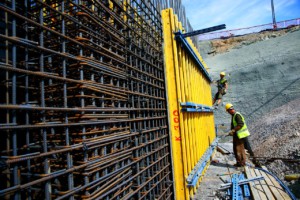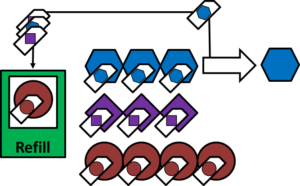 The methods of lean have been adapted to a wide variety of industries, from military to healthcare, from government to banking. One of these industries is lean construction, where it’s applied to the construction industry. In this post I would like to give you an overview of the similarities and differences, and how to adapt lean methods for construction.
The methods of lean have been adapted to a wide variety of industries, from military to healthcare, from government to banking. One of these industries is lean construction, where it’s applied to the construction industry. In this post I would like to give you an overview of the similarities and differences, and how to adapt lean methods for construction.
Introduction
 Construction is a big business. If you drive to work, you probably come across some roadwork, unfortunately often combined with a traffic jam. If you live in a city and look out your window, it’s likely that you’ll see a crane. I just counted eighteen cranes while looking out my window. Since there is always improvement potential wherever something is happening, construction can also benefit from improvement.
Construction is a big business. If you drive to work, you probably come across some roadwork, unfortunately often combined with a traffic jam. If you live in a city and look out your window, it’s likely that you’ll see a crane. I just counted eighteen cranes while looking out my window. Since there is always improvement potential wherever something is happening, construction can also benefit from improvement.
In the automotive industry, a nearly identical car comes down the line every minute, and the worker just needs to reach behind him to grab the part he needs. His work is very standardized and highly regulated. Construction, however, is not like automotive, and there are some major differences.
- First of all, while “normal” industry uses flow shops or job shops, construction usually uses project shops. Rather than the product coming to the machines and parts, the machines and parts come to the product(ion site).
- Additionally, your project is usually not at home, but at the location of the customer. If it would be your own home turf where similar projects happen over and over again, you could optimize your site to your needs. This is done, for example, in ship building, which also uses a large project shop. However, in construction you need to go to the site of the customer, which may be different every time. As a side effect, it may be possible that one aspect is completed before the preceding aspect is finished (like a road that is freshly paved and then dug open again to install pipes).
- Your lot size is small. Rather than making thousands of identical items, in construction you usually work on a unique project every time. In larger projects you may build multiple identical houses, but even then your lot size rarely exceeds a few dozen.
- While your lot size is small, your cycle time is very long. Rather than completing a car every minute, even larger companies rarely complete more than one project per week. Similarly, your lead time is also very long. A car takes a few weeks between start of production and its completion, whereas buildings often take months or even years to complete (or in the case of the infamous new Berlin airport that was supposed to open 2011, apparently never?).
- Overall, these long lead times, cycle times, small lot sizes, and locations at the customer make it more difficult to standardize and optimize the process. Since the projects rarely repeat, and if they do they repeat with a long delay, it is difficult to define the processes clearly.
- On top of that there are often many unscheduled delays. Some of them are due to other companies, while others are due to the weather.
While these differences may make the “usual” approaches a bit more difficult, they do not prohibit the use of lean, but require adaptation to the issues in construction. Let me give you some suggestions:
Improve Repetitive Processes
Even though every construction site is unique, sites do have many repetitive tasks. Please note that the parts do not need to be identical, but the work should include similar steps. The more frequently something is done, the easier it is to optimize. Find these repetitive tasks. Improve them. Optimize the steps and look for waste, unevenness, and overburden (muda, mura, muri).
Establish Kanban for Your In-Stock Material
Kanban, or pull production in general, is a great way to manage inventories of goods that you have regularly in stock. Whenever material is consumed, order more of this material to refill your inventory to its target level.
 You can use regular kanban systems for more valuable items, larger items, or items that spoil quickly. Attach a kanban card to every pallet, bag, or box. Whenever this pallet, bag, or box is used, you take the card as a signal to order one more pallet, bag, or box.
You can use regular kanban systems for more valuable items, larger items, or items that spoil quickly. Attach a kanban card to every pallet, bag, or box. Whenever this pallet, bag, or box is used, you take the card as a signal to order one more pallet, bag, or box.
 For less frequently used items, you can use a two-bin kanban system with two bins (or pallets, boxes or bags, etc.). Whenever one bin is empty, you refill or reorder a bin and use another bin in the meantime.
For less frequently used items, you can use a two-bin kanban system with two bins (or pallets, boxes or bags, etc.). Whenever one bin is empty, you refill or reorder a bin and use another bin in the meantime.

For cheap and small items, you can also use a triangle kanban. While these cards were originally triangular, they can be any shape. You also need only one card per material type. I use these for my A4 paper and printer ink, and generally they are well suited for office material. The last pack of paper has a note to “Order 2500 pages A4” as shown in the image here. Whenever I reach this pack and the kanban, I order more paper. If you consume a lot of paper, you may put the card on the second-to-last stack or even on the last full box of paper.
All of these are described in more detail in my posts Different Ways to Establish a Pull System – Part 1 and Part 2 for more details on the approaches below.
Example of Kanban for Asphalt
 Another example I know was the organization of asphalt delivery for paving streets. There was a small number of trucks supplying asphalt to the paver machine. Originally, these trucks tried to refill with fresh asphalt at the refill station quickly and then return to the site waiting to supply the paver. This resulted in many trucks waiting and the asphalt cooling down, which reduced quality as shown below.
Another example I know was the organization of asphalt delivery for paving streets. There was a small number of trucks supplying asphalt to the paver machine. Originally, these trucks tried to refill with fresh asphalt at the refill station quickly and then return to the site waiting to supply the paver. This resulted in many trucks waiting and the asphalt cooling down, which reduced quality as shown below.
A much better approach was to create a pull system. Rather than full trucks waiting at the paver, empty trucks were waiting at the asphalt plant. When the asphalt in the paver was getting low, a signal was sent to the truck in the asphalt plant to fill up and deliver. The timing of the signal depended on the refill time and the travel time from the plant to the paver plus a bit of buffer for traffic, etc. This ensured that the paver was always supplied with hot asphalt. A similar approach could also be used, for example, for concrete delivery or other “perishable” goods.
Construction Site Layout
Another example is the creation of a construction site layout. During construction you have to store multiple and often bulky materials on site. What do you put where? The idea is to reduce walking distances. Stuff you don’t need like excavated earth will be stored in the back. Offices and break rooms should not be underneath the crane loads for safety reasons. The wood storage could be close to the carpenters shop. Below is an (incomplete and not optimized) example for an European-style stone and concrete construction.
The first plan you come up with is probably far from the best you can do. Usually, creating multiple plans and selecting the best one is often beneficial. The plan can also change over time as the nature of the construction changes. A related tool that may help you is the spaghetti diagram, although due to the often temporary nature of such sites, a spaghetti analysis is more useful as lessons learned for the next site.
Visual Management
Another example is visual management. How can you help your people by marking and labeling your goods? One possible problem at construction sites is the mix up of materials. If you have two types of plaster, you may use the wrong one. Similarly, if you have bricks or wood of different strengths or treatments, you can mix them up. Make sure that they are clearly labeled and maybe colored. You could also store them in different locations like the plaster in the site layout above. There are lots of possibilities, so find what is right for you.
Summary
These are only a few examples of lean tools that could help you in improving your efficiency and quality. There are many more ideas from lean that could be beneficial to your situation. It does not help if you use solutions for problems of Toyota mass production; you have to find solutions that work for your problems! Now go out and organize your industry!





Construction is challenging because the workplace changes throughout the project and different participating groups need to cooperate and be coordinated in space and time. Construction often takes place in close proximity to neighbours or existing infrastructure potentially causing disruption.. Often construction is bespoke and innovative. Testing and commissioning also has to planned and coordinated and is significant in major projects. Satisfying all of the stakeholders can be a delicate balancing act.
Key critical resources such as a site crane have to serve multiple needs and CPA and resource analysis can help project optimisation.
There is the potential to create more in factories and ship to site to be put together rather than being all built on site using basic methodologies with a lot of manual input. Whole constructions can be craned onto the site or completed pods such as a complete bathroom. An example of more factory based construction in the nuclear industry is the Pressurised water Reactor PWR compared with the Advanced Gas Cooled Reactor AGR. The AGR was constructed much more on site than the PWR and impacted quality assurance.
The construction sector was was at the forefront of adopting integrated management systems because of the complications of satisfying multiple stakeholders and impacts on quality, health & safety, environment and commercial success. The universal management system standard MSS 1000 enables a more joined up approach to management construction projects over their complete life-cycle. https://www.integratedmanagement.info/mss-1000
Hi Christopher,
great post as always. I worked for a consulting company and joined some lean construction projects that were very interesting. I agree 100% with your post and it describes the basics that we used in this field.
One thing that we always did was the improvement of the operation ratio from expensive machines e.g. cranes. We scheduled for the whole day what the crane should transport, so that the crane never stops to work. In many cases we could reduce the quantity of cranes in the site in more than 30%.
Anyway, thanks for the great work and for sharing it with us.
Hi Guido, cool idea! Optimize the usage of the most expensive machine to reduce cost by needing less expensive machine (time). I like it!
Hello Christoph,
It’s a good idea to use lean method in construction.
In the following sentence, “large lot size” is wrong? just remaind.
◾Overall, these long lead times, cycle times, large lot sizes, and locations at the customer make it more difficult to standardize and optimize the process.
Thanks for your sharing.
Hi Murphy Yu, dang, you’re right. These are supposed to be SMALL lot sizes. Thanks for pointing that out, error corrected 🙂
Are there any good books to learn more about “lean construction”?
Hi Adam, there are plenty of books on Amazon, but I don’t know how good they are.
Hi Christoph,
thanks to sharing it,
just want to know how to be more familiar with Kanban ( i think like scrum boards) idea more, is there any good source of instruction, it seems more tangible rather than just working with software to me…
great job man,
Hi Armin, on my blog I have multiple articles explaining kanban. Check my list of all posts.